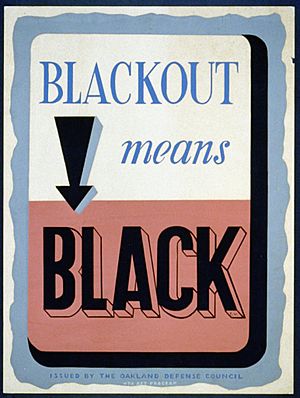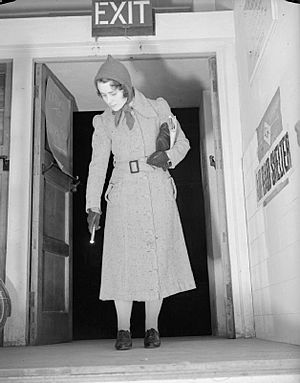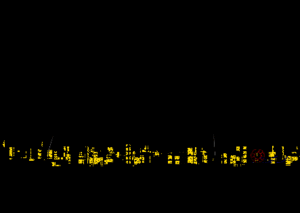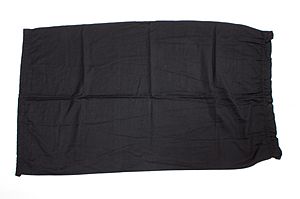Blackout (wartime) facts for kids

A blackout happens during a war, or when a war is expected. It means turning off or hiding most outdoor lights. People did this in the 20th century to stop enemy aircraft from seeing their targets clearly. For example, during the London Blitz in 1940, blackouts made it harder for bombers to find buildings. Near the coast, blackouts also helped protect ships. They prevented ships from being seen against the city lights by enemy submarines far out at sea.
Contents
Blackouts in World War I
United Kingdom's Blackout Rules
In 1913, Winston Churchill, who was in charge of the navy, planned blackouts for British coastal towns. These plans started on August 12, 1914, shortly after the UK joined the war. By October 1914, police in London ordered bright outdoor lights to be turned off or dimmed. Street lamps were partly painted black.
Local authorities handled blackouts in other areas. After Germany started bombing in 1915, some people in towns without blackouts took action. They broke street lamps they thought might attract air raids. By February 1916, blackout rules covered all of England.
France's Blackout Rules
In France, Paris had a blackout when German airships, called Zeppelins, started bombing in spring 1915. These rules were later relaxed. However, they were brought back in spring 1918. This happened when Germany began using large bombers against the city.
Germany's Blackout Rules
Germany only enforced blackouts in a specific area. This zone was about 150 kilometers (93 miles) behind the Western Front.
Blackouts in World War II
United Kingdom's Blackout Experience

During World War II, the British government expected many night air raids. They thought these attacks would cause many deaths and much damage. Everyone agreed that turning off lights would make it harder for enemy planes to navigate and hit targets. As early as July 1939, public leaflets warned people to follow blackout rules strictly.
Blackout rules began on September 1, 1939, even before war was officially declared. These rules said that all windows and doors must be covered at night. People used heavy curtains, cardboard, or paint to stop any light from escaping. The government made sure these materials were available.
Outdoor lights, like street lamps, were turned off or dimmed. They were also shielded to direct light downwards. Important lights, such as traffic lights and car headlights, had covers. These covers directed their beams towards the ground.
Shops and factories faced special challenges. Factories with large glass roofs found it hard to install temporary blackout panels. Permanent methods, like paint, blocked natural light during the day. Shops had to add double "airlock" doors. This stopped light from showing when customers entered or left.
Blackouts were one of the more difficult parts of the war. They disrupted many daily activities. They also caused widespread complaints and lowered people's spirits.
Civilian ARP wardens enforced the blackout. They made sure no building showed even a tiny bit of light. People who broke the rules faced strict legal punishments.
Blackout rules made night driving much more dangerous. As a result, more accidents and deaths occurred. Some rules were relaxed, and speed limits were lowered. Merchant sailors also died by falling into docks at night and drowning during the blackout.
As Germany's ability to fight declined, a "dim-out" was introduced in September 1944. This allowed lighting equal to moonlight. A full blackout would still be ordered if an air raid alert sounded.
United States' Blackout Experience
After the attack on Pearl Harbor, the United States mainland faced some air attacks. These included the bombing of Dutch Harbor and Fu-Go balloon bombs. However, these attacks were small and did not harm American morale or war efforts.
Along the Atlantic coast, there was no coastal blackout. This made Allied ships easy to see against the city lights. This exposed them to German submarine attacks. Coastal towns did not want blackouts because they feared it would hurt tourism. This led to many ships being sunk. German submariners called this period the "Second Happy Time".
How Effective Were Blackouts?
Some historians, like M. R. D. Foot, argue that blackouts did not stop bombers from navigating. He believed navigators focused more on reflective bodies of water, railroad tracks, or large highways.
Blackout Techniques
To create a blackout, lights could simply be turned off. Light could also be reduced by covering windows of large public buildings with tar. During World War II, a dark blackout curtain was used to keep light inside. Covering windows with tar meant a building was semi-permanently blacked out.
In the 1940s and 1950s, cities like Detroit practiced blackout air raid drills. During these drills, the city's Civil Defense workers would sound the neighborhood air raid siren. Families had to follow these steps:
- Turn off all appliances, like stoves, ovens, and furnaces.
- Turn off valves for water and natural gas or propane. Also, disconnect electricity.
- Close blackout curtains. These were plain black curtains that blocked light from entering or leaving. (This step changed after the atomic age. White curtains were then used to reflect the bright flash of an atomic bomb. But in World War II, black curtains stopped enemies from seeing light from windows.)
- Go to a public shelter, a fallout or bomb shelter, or the household basement. Stay there until the local police or block warden said it was safe.
Modern Technology and Blackouts
Today, blackouts are much less effective against a technologically advanced enemy. Even during World War II, aircraft used radio-beam navigation and radar to find targets. For example, the H2X system was used.
Now, air crews have night-vision goggles. Also, advanced satellite-based and inertial navigation systems make it easy to find a fixed target. This is true for both aircraft and guided missiles. Still, during the 1991 Gulf War, authorities in Baghdad practiced blackouts. They did this along with other civil defense procedures before the Gulf War air campaign began bombing the city.



